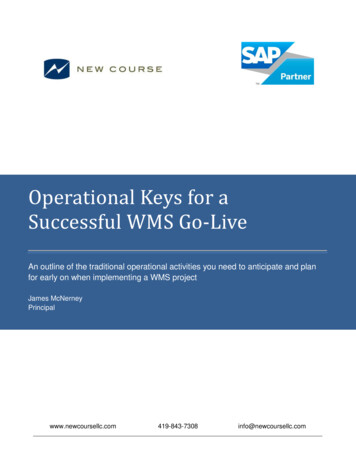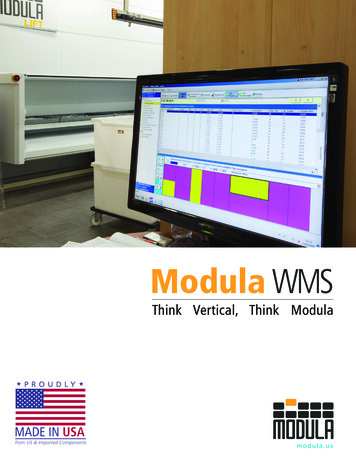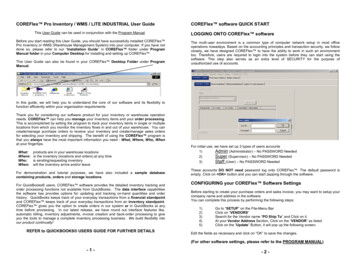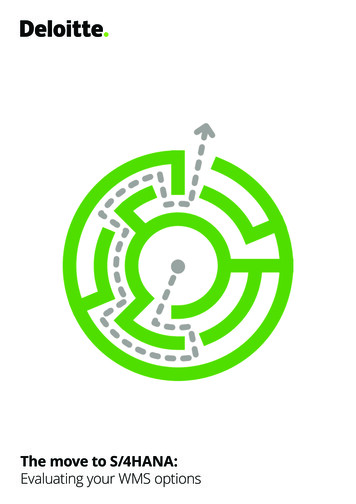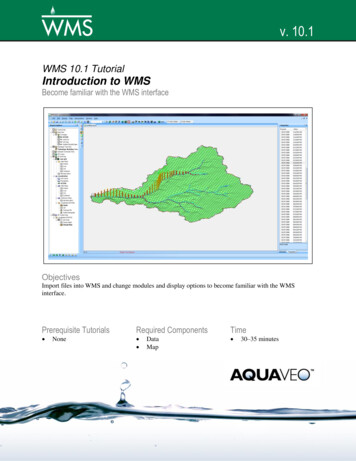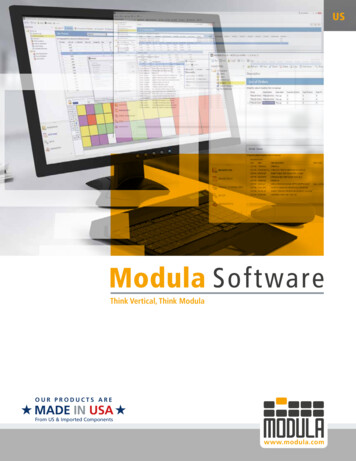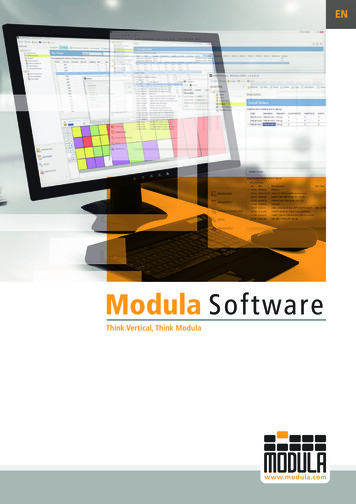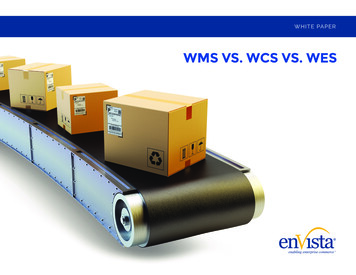
Transcription
WHI TE PAP E RWMS VS. WCS VS. WESTM
WMS manages the flow ofinventory, labor tasks and ordersfrom receipt to shippingEXPLORINGTHE SPECIFICFUNCTIONALITIESOF EACH SOLUTIONIN DEPTH ANDPINPOINTING WHERETHE SYSTEMSINTERSECT WILLALLOW BUSINESSESTO DETERMINE WHICHFUNCTIONS BESTMEET THEIR NEEDS.Many companies are at a crossroad asto whether to invest in a warehousemanagement system (WMS), warehousecontrol system (WCS), warehouse executionsystem (WES) or a combination of the three.The decision is made more confusing becauseof the overlap of some of the functions of eachsystem. Exploring the specific functionalities ofeach solution in depth and pinpointing wherethe systems intersect will allow businessesto determine which functions best meettheir needs, and in turn, which system orcombination of systems will work best.In order to better understand the roles of thethree systems, compare them to the humanbody. Envision the mechanization in thewarehouse, including conveyors, case sorters,tilt-tray sorters and more, as the skeleton.It is rigid and not easy to change once it isin place. The WMS acts as the brain of thefacility, indicating what needs to be done andcommunicating those instructions to the body.The WCS can be compared to the spinal cord;you cannot walk, run or be mobile without it.The WES is somewhat of a combination of thetwo other systems. It is less intelligent than aWMS but still brings some brain power, as wellas the majority of the spinal cord.D E F I N I N G SYST E M SWhat is a WMS?A WMS is a highly specialized businessapplication that controls the flow ofinventory into, within and out of a company’sdistribution center (DC) or multiple DCs. AWMS can verify receipts, put away inventory,replenish inventory to a forward pick location,complete cycle counts, hard allocate inventoryto an order (to be picked), consolidate orderson a dock, and create pack slips, BOLs andcarrier compliant labels. Of the three systemsbeing compared, the WMS is the most mature,intelligent and widely known because itmanages the flow of inventory, labor tasks andorders from receipt to shipping.The WMS knows where products are atall times, as inventory control is its bigdifferentiator; neither a WES nor WCS can
manage all functions of inventory in a distribution center.The inventory management component allows businesses tomanage inventory across the DC and track inventory acrossevery single move. The fundamental data model differencebetween a WMS, WES and WCS is the ability for a WMS tomanage, track and control inventory across multiple channelsand customers (used in 3PLs).The WMS can also be used for exception processes, including:returns, quality assurance and defective product. In addition,most WMS incorporate: Wireless data terminals (RF devices) Bar-coded pallets, cases and item labels Radio frequency identification tags (RFID) Conveyor systems/material handling equipment Voice enabled RF devices Carrier compliant labels Retail compliant labelsWhile WMS encompass vast capabilities, there are somefunctions they do not perform, including: Controling machine language (ladder logic and PLCs) Machine control (starters and motors) Put light, sorters, conveyors, print and apply and ASRSASRS, pick to light, carrousels, print and apply, mergesand de-casing lines. A WCS is able to exchange real-timecommunication, command processing, discrete equipmentsignals and the optimization of material. Most WCS solutionslack advanced WMS functionality. However, the gap is closingas WCS vendors are adding more and more functionalitiesavailable in the WMS space. Traditionally, WCS solutions arewell-suited for highly-automated facilities, but there are fewWCS vendors that have the necessary functionality to manageand control all warehousing processes. Most WCS include: Pack sort management Ship sort management Automated pick management Pick-to-light and put-to-light management Automated conveyor zone skipping Mobile scanner integration Fixed scanner integration Machine control integration In line scales In line print and applyFunctions that WCS do not encompass include: The ability to interface with an enterprise resource planning(ERP) system (in most cases, however, there are exceptions) Tracking carton-level LPNs on automation equipment Hard allocating inventory in reserve or forward pick locations GUI (ACAD) layout of an automation system Supporting wave management strategiesWhat is a WCS?A WCS is a real-time, integrated control solution that managesthe flow of items, cartons and pallets as it travels on manytypes of automated equipment, such as conveyors, sorters, Supporting extensive cycle counting and physicalinventory processes Supporting labor management and allocation Supporting transportation planning and shipping execution
Small and mid-sized retailers can often benefitfrom a WES because it helps to managefulfillment both to consumers and to stores.What is a WES?A WES is a newer breed of solution, compared to a WMS orWCS. A number of systems integrators, WCS control softwarecompanies and material handling equipment manufacturersare moving up stream in terms of adding basic WMSfunctionality into their existing WCS or creating a WES fromscratch. Many WES encompass nearly all functions that arealso included in a WCS and some functions of a WMS. Asa result, a WES is considered a more all-inclusive solution.Think of a WES as a light version of a WMS with controlsfunctionality. WES is encroaching on the WMS territorywhen it comes to tasks related to wave management, lighttask management, inventory management (single channel),picking and shipping.For some businesses, a WES may be all that is needed. Smalland mid-sized retailers can often benefit from a WES becauseit helps to manage fulfillment both to consumers and tostores, but if the retail chain is large, it will likely need themore advanced inventory management component availableonly in a WMS. Most WES include: Basic receiving Shipping management Replenishment management Small-parcel manifesting Non-automated pick management Voice data capture Inventory management Mobile scanner integration Pack sort management Ship sort management Automated pick management Pick-to-light management Automated zone skipping Mobile scanner integrationFunctions that WES do not encompass include: Supply chain integrationERP integration (depends)Management reportingTransportation managementReverse putawayOrder managementWave managementSlottingMulti-variable standard labor management
TH E CROSSOVE RWM S Transportationmanagement integration Order managementintegration ERP integration Advanced receivingWES Shipping management Replenishmentmanagement Small-parcel manifesting Non-automated pickmanagement Management reporting Voice data capture Reverse putaway Inventory managementW CS Pack sorter management Fixed scanner integration Shipping sortermanagement Machine controlintegration Automated pickmanagement Mobile scannerintegration Pick-to-lightmanagement In-line print and apply In-line weightand motion SlottingWMSW MS & W E SW E S & W CSW CS
D E TERMIN ING WHICH SYST E M TO I MP L EMENTThe answer to the question, “which system is right for abusiness?” is always two words – it depends. There are manyfactors that must be considered when deciding which system,or combination of systems, is best for a facility; there simply isno one size fits all solution. Understanding the way inventorymoves throughout a facility is key in determining whichsolution is best. Typically non-automated facilities will needthe sophistication of a WMS while highly-automated facilitieswill need the control a WCS or WES provides, though a WMSmight sometimes also be necessary.When deciding which system to implement, keep future goalsin mind. As these systems can sometimes be extremely costlyto implement and maintain, it’s a decision that is not justabout where a company is now, but where its leaders want itto go. Working with a team of supply chain professionals whounderstand the intricacies and differences between each systemallows businesses to ensure they are getting the best system fortheir unique needs at the right price.There are numerous questions to ask when deciding whichsystem or systems best meet a business’ need.1. How automated or non-automated is the facility?2. How does inventory move through the facility?3. Is the distribution center single channel or multi-channel?4. Is this a 3PL with multiple customers with single signon requirements?5. How many end users do you have (10 or closer to 1,000)?6. How many facilities do you have and do they require asingle view of truth?7. How important is inventory management inyour operation?For more information, please contact877-684-7700 orinfo@envistacorp.comTM
WMS but still brings some brain power, as well as the majority of the spinal cord. DEFINING SYSTEMS What is a WMS? A WMS is a highly specialized business application that controls the flow of inventory into, within and out of a company’s distribution center (DC) or multiple DCs. A


